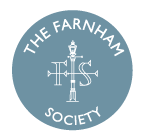Farnham Society Norfolk tour, 15 – 18 September 2017
Building on the success of tours in previous years, our 2017 tour comprised four days in Norfolk.
We were privileged to have a private visit to the home of Sir Antony Gormley, the renowned sculptor and creator of such works as Angel of the North – which we had seen on our 2013 Northumbria visit. Sir Antony spoke of the evolution of sculpture from classical times to the modern day. Classical and Renaissance works were based upon biblical and mythological events, for example the sculptures in the Piazza della Signoria in Florence. Nowadays, following the Age of Enlightment and the Industrial Revolution, people find themselves living in a much changed world, and contemporary sculpture is inspired more by the uncertainties which characterise the modern age.
Works by Sir Antony treat the human body as a space, rather than depicting movement or representing an event. We also saw something of the task of bringing a concept to its final physical form. A work would start as a model in clay, cardboard or polystyrene. The finished item, typically a large metal figure weighing several tons and displayed outdoors, required modern manufacturing techniques.
The theme of sculpture continued with a visit to Houghton Hall. The house is currently host to a temporary exhibition by the sculptor Richard Long, as well as being home to a number of permanent sculptures.
The present house was built in the 18th century by Robert Walpole, the first British Prime Minister. His son Horace, the novelist, later created Strawberry Hill, in Twickenham – which The Farnham Society has also visited.
We visited two sites with a religious heritage. The first was Ely Cathedral, dominating the surrounding fenlands from its elevated position on the Isle of Ely. Beside the Cathedral are extensive former monastic buildings, now retained mostly as official residences.
The second was Walsingham, a major site of pilgrimage in the middle ages, up to the dissolution of the Priory under Henry VIII. Pilgrimage was revived at the end of the 19th century, with the development of two shrines. The Catholic shrine is centred around a restored medieval chapel, the adjacent 20th century chapel emulating the form of a barn. The Anglican shrine sits in the village centre, surrounded by houses from medieval and Georgian periods.
Felbrigg Hall, a national Trust property, is a very different house to Houghton. Much smaller, it was Jacobean in origins though much altered in 18th century. A family home until the mid 20th century, it still has a feeling of being lived in.
Our final day offered something less ‘serious’. A visit to Bressingham gave the opportunity to explore the magnificent gardens developed by four generations of the Bloom family. We were able to enjoy rides on the train and carousel in Alan Bloom’s collection of steam engines and railway carriages.
The exhibition also featured some of the sets and vehicles from the BBC series Dad’s Army, filmed nearby.




